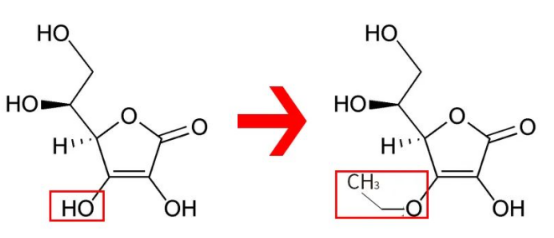Product: Ethyl Ascorbic Acid
Customer from: Singapore
Days ago, there was a Singapore customer who said “we are happy with the EAA. It’s working well in our formulas”.

Plamed ethyl ascorbic acid is white powder and with great water solubility. Ethyl ascorbic acid also is famous as the most stable Vitamin C derivatives, due to its potent effect, and great stability to light, heat, acid, alkali, and air oxidation resistance
Vitamin C is a well-known whitening ingredient and also has the function of promoting collagen synthesis. Vitamin C is often used as an antioxidant and has reducing properties which can inhibit the oxidation of the melanin intermediate dopaquinone into melanin. At the same time, it convert dark oxidized melanin into light-colored reduced melanin, thereby whitening the skin.
However, vitamin C is water-soluble and does not easily penetrate into the stratum corneum of the skin. It is easily oxidized and difficult to preserve. Vitamin C itself has very poor stability and is not easily absorbed by the skin. Therefore, people have been trying to find a way to transform vitamin C into a substance with good stability and easy absorption by the skin. Therefore, there are some vitamin c derivatives.

Figure. vitamin c into Ethyl Ascorbic Acid
- Ethyl Ascorbic Acid: the Most Stable Vitamin C Derivatives
Ethyl ascorbic acid is also called 3-O-ethyl Ascorbic Acid. It is reported that Ethyl Ascorbic Acid is the best vitamin C derivative so far. It is not only very stable in terms of chemical properties, but also after when it enters the skin, it’s easily broken down by biological enzymes and plays the role of vitamin C.
In addition, ethyl ascorbic acid has a lipophilic and hydrophilic amphiphilic structure, making them extremely convenient to use in formulas. In addition, this amphiphilicity makes it easier to penetrate the stratum corneum and enter the dermis, thereby exerting its biological properties. It has the functions of inhibiting tyrosinase activity, blocking melanin formation, antibacterial and anti-inflammatory, also repairing skin cell activity, and promoting collagen production.
- Skin Whitening Mechanismof Ethyl Ascorbic Acid
Ethyl ascorbic acid can inhibit tyrosinase activity, and act directly on DHICA to prevent the formation of melanin. In the process of melanin synthesis, tyrosinase is a necessary condition for catalyzing the first two steps of melanin synthesis. In the first step, tyrosine is oxidized to dopa and then to dopaquinone by the action of tyrosinase. Therefore, the inhibition of tyrosinase is the key to skin whitening. As for DHICA, one of the causes of melanin that has already formed, ethyl ascorbic acid can directly act on DHICA to prevent it from converting into melanin when exposed to UVA, thereby achieving a whitening effect.
- Good Skin Penetrationof Ethyl Ascorbic Acid
Several researchers from the University of London in the UK used ethyl ascorbic acid to compare the permeability of the LabSkin model and the human skin model. It was found that the 24-hour penetration rate of ethyl ascorbic acid delivered through LabSkin was 55.1±1.8%. Human skin penetration was similar, accounting for 58.0±4.2% of the applied dose (p>0.05).

- Skin Whitening Effect of Ethyl Ascorbic Acid
In the article “The Anti-Ageing and Whitening Potential of a Cosmetic Serum Containing 3-O-ethyl-L-ascorbic Acid”, the spot-bleaching ability of the 30% EAA and 1% lactic acid composition was specifically evaluated. This is research done on the Reconstructed Human Pigmented Epidermis (RHPE). The results found that the melanin content in the control group was 20.0μg/mL, while the melanin content in the experimental group was reduced to 16.60μg/mL, a significant decrease of 17.10%.

The study results showed that after 9 days, compared with the first day, the black area shown by 3% concentration of 3-O-ethyl ascorbic acid is a significant reduction of melanin in melanocytes. It indicates that ethyl ascorbic acid has excellent skin-brightening activity. After the whitening emulsion added with ethyl ascorbic acid was used for 28 days on Asian healthy people, the Ita angle increased by 4% according to chromatographic evaluation, and the obvious whitening effect can be observed with the naked eye.

Figure. Ethyl Ascorbic Acid skin whitening effect within 28-days
Ethyl ascorbic acid, as the most stable Vitamin C derivatives for skin whitening, is widely used in gel, essence, lotion, cream and other skincare products. There re some formulation suggestions when using ethyl ascorbic acid:
- The addition dosageis 0.1%-3.0%.
- It is recommended to add 0.2% sodium lemon acid to the formula, then add to the system below 40℃.
- The pH of the formulation is controlled in around0 to achieve the best effect.







